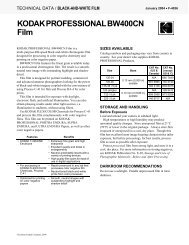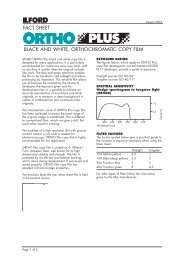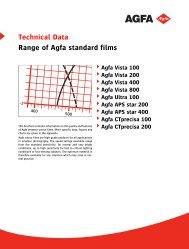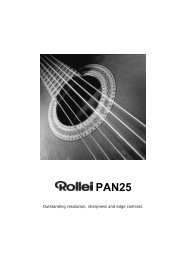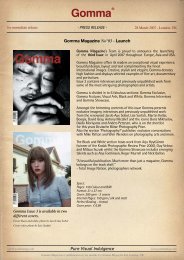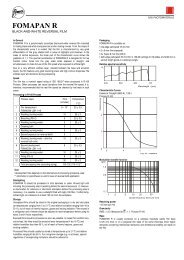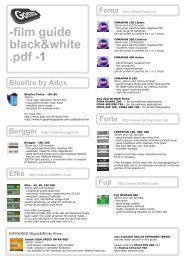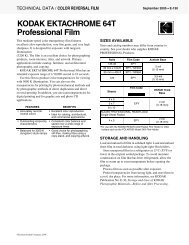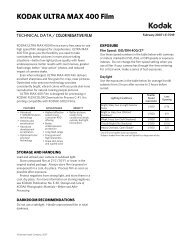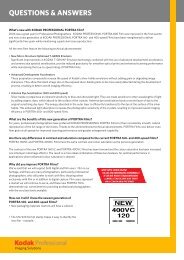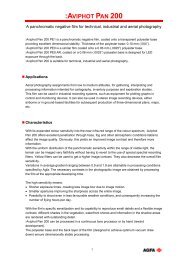Ilford SFX 200 - Gomma
Ilford SFX 200 - Gomma
Ilford SFX 200 - Gomma
Create successful ePaper yourself
Turn your PDF publications into a flip-book with our unique Google optimized e-Paper software.
FACT SHEET<br />
<strong>SFX</strong><br />
BLACK AND WHITE CAMERA FILM<br />
WITH EXTENDED RED SENSITIVITY FOR CREATIVE PHOTOGRAPHY<br />
April <strong>200</strong>4<br />
DESCRIPTION<br />
ILFORD <strong>SFX</strong> <strong>200</strong> is a medium speed black and<br />
white camera film for creative photography. It has<br />
extended red sensitivity (up to 740nm) and is<br />
especially suited for use with a filter to create<br />
special effects. Using a very deep red filter, for<br />
example the ILFORD <strong>SFX</strong> filter, skies can be<br />
rendered almost black and most green vegetation<br />
almost white. Its unusual tonal rendition ensures<br />
interesting results for a range of subjects, including<br />
portraits, landscapes, townscapes and architecture.<br />
Best results are often obtained in bright sunshine or<br />
in the studio under tungsten lighting.<br />
<strong>SFX</strong> <strong>200</strong> also has full panchromatic sensitivity to<br />
ensure good pictorial contrast with or without the<br />
use of a filter. It has a wide exposure latitude, is<br />
compatible with all normal developers and has a<br />
wide tonal range.<br />
AVAILABILITY<br />
<strong>SFX</strong> <strong>200</strong> is coated on 0 . 125mm/5-mil grey<br />
acetate base which gives good halation<br />
protection. <strong>SFX</strong> <strong>200</strong> 35mm film is available in 36<br />
exposure DX coded cassettes, suitable for all<br />
35mm cameras. <strong>SFX</strong> <strong>200</strong> rollfilm is available in<br />
120 lengths and is edge numbered 1 to 19.<br />
EXPOSURE RATING<br />
<strong>SFX</strong> <strong>200</strong> has a speed rating of ISO <strong>200</strong>/24°<br />
(<strong>200</strong>ASA, 24DIN, EI <strong>200</strong>/24) to daylight. The ISO<br />
speed rating was measured using ILFORD ID-11<br />
developer at 20°C/68°F with intermittent agitation<br />
in a spiral tank.<br />
It should be noted that the exposure index (EI)<br />
range recommended for <strong>SFX</strong> <strong>200</strong> is based on a<br />
practical evaluation of film speed and is not based<br />
on foot speed, as is the ISO standard.<br />
SPECTRAL SENSITIVITY<br />
Wedge spectrogram to tungsten light<br />
(2850K)<br />
Wavelength (nm)<br />
<strong>SFX</strong> <strong>200</strong> has a peak red sensitivity at 720nm and<br />
extended red sensitivity up to 740nm.<br />
USE OF FILTERS<br />
Any yellow, orange or red filter may be used, but the<br />
effect will depend on its transmission characteristics.<br />
The redder the filter, the more dramatic the effect. The<br />
ILFORD <strong>SFX</strong> very deep red filter is recommended.<br />
Suggested filters include:<br />
Filter factors<br />
Filter Filter Filter Exposure<br />
colour factor increase<br />
(stops)<br />
Kodak Wratten<br />
3 Very light yellow 2 1<br />
8 Yellow 2 1<br />
12 Deep yellow 2 . 3 1 1 /3<br />
15 Very deep yellow 2 . 4 1 1 /3<br />
21 Orange 2 . 4 1 1 /3<br />
23a Reddish orange 2 . 5 1 1 /3<br />
25 Red 2 . 8 1 1 /2<br />
29 Deep red 3 1 2 /3<br />
89B Very deep red 16 4<br />
ILFORD<br />
<strong>SFX</strong> <strong>200</strong> Very deep red 16 4<br />
Sensitivity<br />
Very deep red<br />
ILFORD <strong>SFX</strong>, B+W RG665, B+W 092, Heliopan<br />
695 and 715, Hoya R72 and Kodak Wratten<br />
89B. These filters give an even more dramatic<br />
effect than deep red filters. However, exposure<br />
times with these filters can be very long, so the use<br />
of a tripod is recommended.<br />
Deep red<br />
B+W 091, Heliopan 29, Kodak Wratten 29 and<br />
Rodenstock 29. These filters give a more dramatic<br />
effect than red filters.<br />
Page 1 of 6
<strong>SFX</strong> <strong>200</strong><br />
Red<br />
B+W 090, Cromatek HC4, Cokin 003, Hitech 25,<br />
Hoya 25A, Jessop R2, Kodak Wratten 25, Lee 25<br />
and Rodenstock 25. Under some conditions, the<br />
effect with these filters can be quite subtle – similar<br />
to a normal panchromatic film used with these<br />
filters.<br />
Several camera manufacturers also sell similar<br />
filters, including Nikon, Canon and Leica.<br />
Filters are available in different forms ranging from<br />
gelatin, resin, plastic to glass. This table gives a<br />
guide.<br />
Filter<br />
Type<br />
B+W 090, 091, Glass, screw-in or bayonet<br />
RG665, 092<br />
Cokin 003<br />
Resin<br />
Cromatek HC4 Resin<br />
Heliopan 29, 695, 715 Glass, screw-in<br />
Hitech 25<br />
Resin<br />
Hoya 25A, R72 Glass, screw-in or bayonet<br />
ILFORD <strong>SFX</strong><br />
Gelatin with or without a<br />
mount<br />
Kodak Wratten 25, 29, Gelatin<br />
89B<br />
Lee 25<br />
Polyester or resin<br />
Rodenstock 25, 29 Glass, screw-in<br />
Note Some of these filters may be available only<br />
by special order.<br />
ILFORD <strong>SFX</strong> FILTER<br />
The ILFORD <strong>SFX</strong> deep red filter is recommended<br />
for use with this film. It is supplied as 58x58mm<br />
(2.3x2.3in) or 75x75mm (3x3in) gelatin sheets.<br />
The larger size is also available in a Cokin mount.<br />
LOADING THE CAMERA<br />
<strong>SFX</strong> <strong>200</strong> must be loaded in subdued light. Unlike<br />
true infra-red film, it is not necessary to load it in<br />
total darkness.<br />
FOCUSING<br />
With some lenses, red light focuses at a slightly<br />
different point to other visible light. With these<br />
lenses there may be a focus shift when focusing in<br />
white light compared with red light. However, it is<br />
almost impossible to focus a camera with a deep<br />
red filter in place.<br />
With short to moderate focal length lenses, this<br />
difference can easily be accommodated by<br />
stopping down the lens to the smallest workable<br />
aperture. Some lenses, particularly apochromatic<br />
(APO) designs, may need no correction.<br />
EXPOSURE<br />
A certain amount of experimentation is needed<br />
when first using this film. As a guide, bracket<br />
exposures by ±2 stops from the TTL reading with<br />
the filter in place or the meter reading with the filter<br />
factor applied.<br />
Note The TTL metering on some cameras can<br />
under expose by up to 1 1/ 2-stops with deep red or<br />
orange filters in place.<br />
CHOOSING THE BEST ILFORD DEVELOPER FOR THE JOB<br />
Manual processing (eg spiral tank, deep tank) and rotary processors<br />
Liquid<br />
Powder<br />
Best overall image quality at meter setting<br />
EI <strong>200</strong>/24 ILFOTEC DD-X ID-11 (stock)<br />
EI 400/27 ILFOTEC DD-X ID-11 (stock)<br />
EI 800/30 ILFOTEC DD-X ID-11 (stock)<br />
Finest grain ILFOTEC DD-X PERCEPTOL<br />
Maximum sharpness ILFOSOL S ID-11 (1+1)<br />
Maximum film speed ILFOTEC DD-X MICROPHEN (stock)<br />
One-shot convenience ILFOSOL S ID-11 (1+1)<br />
ILFOTEC DD-X MICROPHEN (1+1)<br />
Economy ILFOTEC LC29 (1+29) ID-11 (1+1)<br />
MICROPHEN (1+1)<br />
Rapid processing ILFOTEC HC (1+15) –<br />
Replenishable ILFOTEC HC ID-11<br />
Machine processing<br />
Dip and dunk ILFOTEC DD Best overall image quality (liquid) and long tank life<br />
ID-11<br />
Best overall image quality (powder) and long tank life<br />
ILFOTEC HC<br />
Flexible process time, range of dilutions and economy<br />
Short leader ILFOTEC RT RAPID Rapid processing, best overall image quality and<br />
long tank life<br />
ILFOTEC HC<br />
Range of dilutions, flexibility and economy<br />
Roller transport ILFOTEC RT RAPID Rapid processing<br />
Page 2 of 6
<strong>SFX</strong> <strong>200</strong><br />
If you want to check the TTL metering system on<br />
your camera before starting, set the metering<br />
system of the camera to EI <strong>200</strong>/24 and, with your<br />
filter in place, make a series of exposures up to ±2<br />
stops from the indicated exposure. After processing<br />
decide which is the best negative and re-set the<br />
camera if necessary. As an example, the correct<br />
exposure in bright sunlight with the ILFORD <strong>SFX</strong><br />
filter is around 1/ 30 second at f5.6.<br />
PROCESSING<br />
<strong>SFX</strong> <strong>200</strong> can be processed in all types of<br />
processing equipment including spiral tanks, rotary<br />
processors, deep tanks and automatic processors.<br />
Standard capacity figures and replenishment rates<br />
can be maintained. <strong>SFX</strong> <strong>200</strong> is very robust in<br />
processing and will tolerate less than ideal<br />
processing conditions. Also, it will not contaminate<br />
the processing chemicals.<br />
Development times<br />
The table gives development times for both manual<br />
and machine processing. These times will produce<br />
negatives of average contrast suitable for printing<br />
in all enlargers. The development times are<br />
intended as a guide and may be altered if a<br />
different result is needed. For manual processing in<br />
spiral tanks and deep tanks, the development times<br />
are based on intermittent agitation. Where<br />
continuous agitation is used for manual processing<br />
(as with some types of processing tank), reduce<br />
these times by up to 15%.<br />
For use in rotary processors without a pre-rinse,<br />
reduce the spiral tank development times by up to<br />
15%. Generally, a pre-rinse is not recommended<br />
as it can lead to uneven processing.<br />
Note Development times may need adjusting to<br />
suit individual exposing conditions, processing<br />
systems and working practices. Adjust the<br />
recommended development times until the desired<br />
contrast level is obtained. Development times in<br />
other manufacturers’ developers are included for<br />
your convenience and are only a general guide.<br />
Adjust these times, if necessary, to suit your<br />
requirements. Other manufacturers can and do<br />
change their products’ specifications from time to<br />
time and the development times may change as a<br />
result.<br />
Page 3 of 6
<strong>SFX</strong> <strong>200</strong><br />
Development times<br />
35mm film and rollfilm<br />
Dilution<br />
Meter setting<br />
EI <strong>200</strong>/24 EI 400/27 EI 800/30<br />
Spiral tank, deep tank, dip and dunk machines (min/20°C/68°F)<br />
ILFORD developer<br />
ILFOTEC DD-X 1+4 10 14 –<br />
ILFOSOL S 1+9 9 1/ 2 11 1/ 2 19<br />
1+14 13 19 –<br />
ILFOTEC HC 1+15 5 7 10 1/ 2<br />
1+31 9 13 19<br />
ILFOTEC LC29 1+9 5 7 10 1/ 2<br />
1+19 9 13 19<br />
1+29 11 – –<br />
ID-11 stock 10 14 18<br />
1+1 17 – –<br />
MICROPHEN stock 8 1/ 2 10 1/ 2 14 1/ 2<br />
1+1 15 1/ 2 19 –<br />
PERCEPTOL stock 14 1/ 2 – –<br />
1+1 20 – –<br />
Non-ILFORD developer<br />
Agfa Refinal stock 8 11 1/ 2 –<br />
Kodak D-76 stock 10 12 1/ 2 16 1/ 2<br />
1+1 14 1/ 2 – –<br />
Kodak T-Max 1+4 8 1/ 2 10 1/ 2 12 1/ 2<br />
Kodak Xtol stock 7 11 –<br />
Kodak HC 110 A 5 7 10 1/ 2<br />
B 9 13 19<br />
Tetenal Ultrafin 1+10 10 13 –<br />
Dip and dunk machines (min/24°C/75°F)<br />
ILFOTEC DD 1+4 8 1/ 2 11 1/ 2 14<br />
Kodak T-Max RS stock 6 7 9<br />
Kodak Xtol stock 7 9 11 1/ 2<br />
ILFOLAB FP40, roller transport and short leader machines (sec/26°C/78.8°F)<br />
ILFOTEC RT RAPID 1+1+2 54 65 88<br />
1+1+5 65 90 120<br />
Kodak Duraflo RT stock 100 135 <strong>200</strong><br />
Page 4 of 6
<strong>SFX</strong> <strong>200</strong><br />
Processing at different temperatures<br />
<strong>SFX</strong> <strong>200</strong> film can be processed over a range of<br />
temperatures. Development times at temperatures<br />
other than 20°C/68°F may be calculated from the<br />
chart below.<br />
For example, if 4 minutes at 20°C/68°F is<br />
recommended, the time at 23°C/73°F will be 3<br />
minutes and the time at 16°C/61°F will be 6<br />
minutes.<br />
New development time (min)<br />
New development time (min)<br />
Agitation<br />
Intermittent agitation is recommended for use in<br />
spiral tanks and deep tanks. With spiral tanks,<br />
invert the tank four times during the first 10<br />
seconds, then invert the tank four times again<br />
during the first 10 seconds of each further minute.<br />
Otherwise, follow the recommendations given by<br />
the processing equipment manufacturer.<br />
Temperature (°C)<br />
Temperature (°F)<br />
Stop, fix, wash and rinse<br />
For best results it is recommended that all process<br />
solutions are kept at the same temperature or at<br />
least within 5ºC (9ºF) of the developer<br />
temperature.<br />
Stop Bath<br />
After development the film can be rinsed in water<br />
but we recommend that an acid stop bath is used<br />
such as ILFORD ILFOSTOP (with indicator dye) or<br />
ILFOSTOP PRO (without indicator dye). ILFOSTOP<br />
PRO is recommended for all machine processing<br />
applications. When tanks or dishes (trays) of<br />
process solutions are in use a stop bath<br />
immediately stops development and reduces carry<br />
over of excess developer into the fixer bath. This<br />
helps to maintain the activity and prolong the life<br />
of the fixer solution.<br />
ILFORD Stop ILFOSTOP ILFOSTOP PRO<br />
Bath<br />
Dilution 1+19 1+19<br />
Temperature 18–24ºC 18–24ºC<br />
range (64–75ºF) (64–75ºF)<br />
Time (seconds)<br />
at 20ºC (68ºF)<br />
10 10<br />
Capacity<br />
films/litre 15x(135–36) 22x(135–36)<br />
(unreplenished)<br />
The process time given is the minimum required, if<br />
necessary a longer time may be used and should<br />
not cause any process problems provided it is not<br />
excessive.<br />
Fix<br />
The recommended fixers are ILFORD RAPID FIXER<br />
and ILFORD HYPAM liquid fixers and ILFORD<br />
ILFOFIX II powder fixer,all are non-hardening<br />
fixers.<br />
ILFORD Fixer ILFORD HYPAM & ILFORD<br />
ILFORD RAPID FIXER ILFOFIX II<br />
Dilution 1+4 stock<br />
Temperature 18–24ºC 18–24ºC<br />
range (64–75ºF) (64–75ºF)<br />
Time (mins)<br />
at 20ºC (68ºF)<br />
2–5 4–8<br />
Capacity<br />
films/litre 24x(135–36) 24x(135–36)<br />
(unreplenished)<br />
Page 5 of 6
<strong>SFX</strong> <strong>200</strong><br />
WASH<br />
When a non-hardening fixer has been used wash<br />
the films in running water for 5–10 minutes at a<br />
temperature within 5ºC (9ºF) of the process<br />
temperature.<br />
For spiral tank use, when a non-hardening fixer<br />
has been used, the following method of washing is<br />
recommended. This method of washing is faster,<br />
uses less water yet still gives negatives suitable for<br />
long term storage.<br />
After fixing, fill the spiral tank with water at the<br />
same temperature, +/– 5ºC (9ºF), as the<br />
processing solutions and invert it five times. Drain<br />
the water away and refill. Invert the tank ten times.<br />
Once more drain the water away and refill.<br />
Finally, invert the tank twenty times and drain the<br />
water away.<br />
Rinse<br />
For a final rinse use ILFORD ILFOTOL wetting<br />
agent added to water, it helps the film to dry<br />
rapidly and evenly. Start by using 5ml per litre of<br />
rinse water (1+<strong>200</strong>), however the amount of<br />
ILFOTOL used may need some adjustment<br />
depending on the local water quality and drying<br />
method. Too little or too much wetting agent can<br />
lead to uneven drying. Remove excess rinse<br />
solution from the film before drying.<br />
FIX HARDENER<br />
ILFORD RAPID FIXER and ILFORD ILFOFIX II must<br />
not be used with fix hardeners as they are not<br />
compatible with them. If a fix hardener is required<br />
then only ILFORD HYPAM fixer can be used. Add<br />
ILFORD HYPAM HARDENER to turn HYPAM into a<br />
hardening fixer.<br />
Generally for most applications modern camera<br />
films are sufficiently hardened at manufacture.<br />
Additional hardening from a fixer hardener is not<br />
usually needed or recommended for processing in<br />
spiral tanks, dishes/trays, deep tanks, rotary<br />
processors, dip and dunk (hanger) machines and<br />
short leader card processors, unless the processing<br />
temperature is above 30ºC (86ºF), or poor drying<br />
performance is being experienced. To minimise the<br />
risk of physical damage a fixer hardener may be<br />
needed when using a roller transport film<br />
processor.<br />
Using a fix hardener will require the recommended<br />
fix and wash times to be extended. Depending on<br />
the film and processing conditions the hardened<br />
fix time will be between 4 and 10 minutes and the<br />
subsequent wash time 10–20 minutes in running<br />
water.<br />
The amount of HYPAM HARDENER that can be<br />
added to the fixer is dependant on the film and<br />
process conditions used. In some processors the<br />
full amount of hardener cannot be used as the fix<br />
and wash times cannot be extended adequately. In<br />
these circumstances we recommend starting with<br />
Page 6 of 6<br />
the minimum amount of hardener to have some<br />
effect. This is around 3–6 mls of hardener per litre<br />
of working strength HYPAM used. This increases<br />
the film hardness slightly but has a negligible effect<br />
on the fix and wash efficiency. When fix and wash<br />
times are restricted the maximum amount of<br />
HYPAM HARDENER recommended is 10–20ml of<br />
hardener per litre of working strength HYPAM<br />
used. This higher amount gives a definite increase<br />
to the hardness of the films processed and while<br />
fixing and washing efficiency are reduced the films<br />
will be adequately fixed and washed for most<br />
purposes.<br />
When fix and wash times can be extended the<br />
maximum amount of HYPAM HARDENER needed<br />
to achieve fully hardened films is 1 part to 40<br />
parts working strength HYPAM i.e. 24 ml per litre.<br />
Drying<br />
To avoid drying marks, use a clean squeegee or<br />
chamois cloth to wipe <strong>SFX</strong> <strong>200</strong> film before<br />
hanging it to dry. Dry <strong>SFX</strong> <strong>200</strong> at 30–40°C/86-<br />
104°F in a drying cabinet or at room temperature<br />
in a clean dust-free area.<br />
PRINTING<br />
<strong>SFX</strong> <strong>200</strong> negatives can be printed in a similar way<br />
to conventional panchromatic films. However,<br />
because of the shift in relative tonal values a<br />
degree of experimentation may be necessary to<br />
get the desired result.<br />
Experienced rollfilm users will notice that <strong>SFX</strong> <strong>200</strong><br />
rollfilm negatives feel and look a little different to<br />
other ILFORD rollfilms. This makes no difference to<br />
the final prints.<br />
The range of ILFORD MULTIGRADE variable<br />
contrast papers is particularly recommended.<br />
STORAGE<br />
Store <strong>SFX</strong> <strong>200</strong> in a cool (10–20°C/50-68°F), dry<br />
place in its original packaging.<br />
Exposed film<br />
Once exposed, process <strong>SFX</strong> <strong>200</strong> as soon as<br />
practical. Images on exposed but unprocessed film<br />
will not degrade for up to several months when<br />
stored as recommended.<br />
Negatives<br />
Store processed negatives in a cool (10–20°C/50-<br />
68°F), dry place, in the dark. Suitable storage<br />
sleeves include those made of cellulose triacetate,<br />
Mylar, paper (pH6 . 5–7 . 5) or inert polyester.<br />
A wide range of fact sheets is available which describe and<br />
give guidance on using ILFORD products. Some products in<br />
this fact sheet might not be available in your country.<br />
ILFORD Imaging UK Limited, Town Lane, Mobberley<br />
Knutsford, Cheshire WA16 7JL, England<br />
www.ilford.com<br />
95084.GB.www April <strong>200</strong>4




